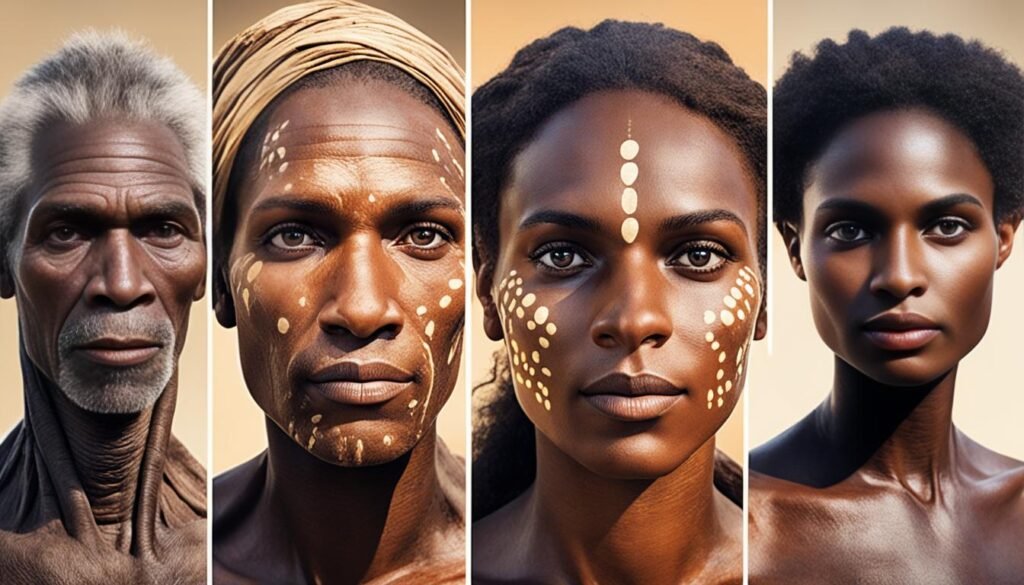Does skin color mean anything?
Have you ever wondered why human beings have such diverse skin colors? Is there a deeper significance behind the shades that range from the darkest ebony to the palest ivory? In a society where myths and misconceptions about skin color abound, it’s essential to explore the science behind this fascinating aspect of our physical appearance. Let’s delve into the significance of skin color, uncovering the truths that challenge common beliefs and highlight the beauty of diversity.
Key Takeaways:
- Skin color is determined by genetics, sun exposure, and environmental factors.
- Melanin, produced by melanocytes, is the main determinant of skin color.
- Differences in skin color evolved through natural selection and sexual selection.
- Skin color holds social significance, leading to discrimination and stereotypes.
- Embracing diversity and challenging societal constructs are crucial for a more inclusive world.
The Genetics of Skin Color
Understanding the genetics behind skin color involves delving into the fascinating world of melanocytes, melanin, and the complex genetic mechanism that determines the diverse range of skin tones in humans.
Melanin, the pigment responsible for skin color, is produced by specialized cells called melanocytes. These pigment-producing cells are located in the basal layer of the epidermis, where they produce and distribute melanin to surrounding skin cells.
The genetic mechanism governing skin color primarily revolves around the enzyme tyrosinase. This crucial enzyme plays a vital role in creating not only the color of our skin but also the shades of our eyes and hair.
Melanocytes produce two distinct types of melanin – eumelanin and pheomelanin. Eumelanin is a brown-black pigment that is predominantly found in individuals with darker skin tones. On the other hand, pheomelanin is a pink to red pigment primarily found in individuals with red hair, freckles, and certain areas of the body.
The amount and type of melanin produced in the skin are controlled by various genes that operate under incomplete dominance. These genes exist in different forms known as alleles, resulting in the vast array of skin tones seen among humans.
Intriguingly, while specific genes influence the production of melanin, genes related to other physical characteristics can also impact skin color. For instance, variations in the MC1R gene, which regulates the production of red hair, can contribute to different skin tones.
The Role of Melanocytes and Melanin Production
Melanocytes play a pivotal role in determining skin color through the production and distribution of melanin. When exposed to ultraviolet (UV) radiation from the sun, melanocytes increase their melanin production to protect the skin from potential DNA damage caused by UV rays.
Interestingly, eumelanin provides a greater level of protection against UV radiation compared to pheomelanin. This explains why individuals with lighter skin tones are more susceptible to sunburn and skin damage from excessive sun exposure.
Fact: The production of melanin is an evolutionary adaptation aimed at safeguarding human skin from the harmful effects of UV radiation by absorbing or reflecting the sun’s rays.
It is the delicate interplay between genetic factors and environmental influences that contributes to the incredible diversity of skin tones found in humans. This diversity, a testament to our genetic heritage and the genetic adaptability of our species, is a celebration of the beauty of human variation.
As we continue to unravel the intricate genetic mechanisms behind skin color, we gain a deeper understanding of the fascinating complexities that make each individual unique.
| Type of Melanin | Description |
|---|---|
| Eumelanin | A brown-black pigment found in people with darker skin |
| Pheomelanin | A pink to red pigment found in people with red hair and certain areas of the body |
The Evolution of Skin Color
The evolution of skin color in humans is a fascinating process that can be attributed to several factors, including thermoregulation, endurance running, natural selection, migration, and the need for vitamin D production.
One key aspect of our evolution is related to thermoregulation. As Homo sapiens evolved, they gradually lost their body hair, which was advantageous for cooling the body during intense physical activities. However, this hairlessness exposed the skin to the harmful effects of UV radiation, particularly the degradation of folate. To counteract this, the development of skin pigmentation became essential for protection.
The dark skin of early humans played a crucial role in enabling them to thrive in environments with intense sunlight. This adaptation allowed them to engage in activities such as walking, running, and foraging for extended periods without overheating. By absorbing and dissipating sunlight, their dark skin helped regulate their body temperature, making endurance running and prolonged exposure to the sun possible.
As humans began to migrate away from the tropics and into regions with less intense sunlight, a lighter skin color became advantageous. In these new environments, lighter skin facilitated increased production of vitamin D in the body, an essential nutrient for bone health, immune function, and overall well-being. This evolutionary change ensured that populations migrating to higher latitudes could effectively utilize the limited sunlight available to them for vitamin D synthesis.
Over time, the process of migration and admixture between different populations led to the diverse range of skin pigmentation that we observe today. While the original purpose of skin color evolution was primarily practical, it eventually resulted in the formation of unique characteristics and traits across different regions of the world.
| Evolvement Factors | Implications |
|---|---|
| Thermoregulation | Helped regulate body temperature during physical activities. |
| Endurance Running | Enabled prolonged exposure to the sun without overheating. |
| Natural Selection | Drove the adaptation of skin color for survival and well-being. |
| Migration | Facilitated the spread of different skin color variations across regions. |
| Vitamin D Production | Ensured optimal vitamin D synthesis in varying sunlight conditions. |
The evolution of skin color highlights the intricate interplay between genetics, environment, and the effects of natural selection. It serves as a testament to the adaptability and resilience of the human species. Embracing the diversity in skin color is not only essential in understanding our shared history as a global community but also in challenging societal constructs and promoting inclusivity.

The Significance of Migration
Migrations played a pivotal role in the spread and diversification of skin color. As populations moved to different regions, they encountered new environments with varying levels of UV radiation. This presented the opportunity for natural selection to act upon the genes responsible for skin pigmentation, leading to the development of distinct skin tones that were best suited for the local climate. The phenomenon of migration, combined with the forces of natural selection, contributed to the beautiful mosaic of skin color diversity we see today.
Conclusion
Skin color serves as a visible adaptation to our environment, with diverse populations exhibiting different shades of skin based on proximity to the equator or poles. However, the social constructs associated with skin color have resulted in discrimination and stereotypes throughout history and across cultures. It is crucial to understand that skin color does not determine an individual’s worth or intelligence – it is simply a physical characteristic influenced by genetics, environment, and cultural behaviors.
To foster a more inclusive and equitable world, we must embrace diversity and challenge the societal constructs that perpetuate biases related to skin color. Breaking free from these constructs requires open-mindedness, empathy, and a commitment to unlearn preconceived notions. By acknowledging the individual’s inherent value regardless of their skin color, we can create a society that celebrates the richness and beauty of our diverse human experiences.
By recognizing that skin color is a mosaic that paints a rich tapestry of human history and heritage, we can foster mutual respect, understanding, and appreciation for our differences. Let us strive for unity, equity, and justice, transcending the limitations of social constructs to create a world where everyone is valued for who they are, irrespective of their skin color.






